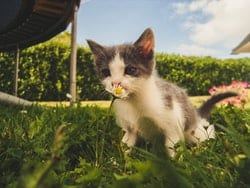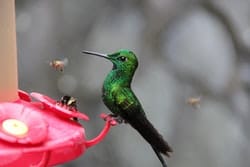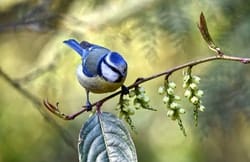Bees are typically not aggressive creatures if you leave them alone, although, in reality, the same cannot be said for the Africanized Honey Bee species. However, there are instances when they get riled up and attack. It is during these times when bees can cause the most harm to humans, pets and other living creatures. Even if they tend to attack you without you knowing why it is still important that you treat these creatures with respect; they are after all the major pollinators in our planet.
Armed with their main defense mechanism, bees will only sting as a last resort as their stingers are often ripped off their bodies together with the venom sac after they drive it through their target, causing the bee’s death. You might feel unlucky because you got stung, but the bee who’s stung got embedded on your skin is the unluckier one.
Table of Contents
Can bees harm cats or kittens?
The reason why your cat might get stung by a bee is when he tries to swat or play with the insect, stumble upon a hive or just plainly in the wrong place at the wrong time. The level of the reaction of your cat to the sting can be categorized into two: mild and severe.

Yes, but most cats fall on the mild reaction category and would only need your assistance in helping them remove the lodged stinger in their body. It is important that you remove the stinger as soon as possible because even if it is severed from the main body of the bee, it continues to pump bee venom and also release a pheromone that signals the other bees to attack. Place a cool, wet towel on the site of the sting to help alleviate the burning sensation and swelling on the area.
There is a small percentage of cats that have severe allergic reactions to a bee sting. If you suspect your cat to be experiencing one, then the best course of action is to remove the sting, place a cold, wet towel on the affected area and call the vet. Depending on the severity of the reaction, your cat may go into shock, so working fast in addressing the issue is the key.
As for kittens, expect them to be more on the severe reaction side because of the small size they have. Your adult cat may have a mild reaction, but your smaller kitten might have a more severe one. Bring them directly to a vet when you see them exhibit severe allergic reaction to a bee sting. It can be a life or death situation for your furry little friend.
Can bees harm dogs or puppies?
Yes, and just like us humans, dogs may have a severe allergic reaction to a bee sting. This severe reaction is called anaphylactic shock, and it can be fatal to our four-legged companions. Consider yourself lucky if your dog belongs to the majority that is not allergic to bee venom. The main action you need to take after your dog gets stung is to remove the sting from the area. You’ll be able to determine if your dog is stung by a bee if you find him scratching and biting a certain area of his body and if upon closer inspection, you see red, swollen skin on your dog.

Puppies, with their small bodies, may be more severely affected by bee stings especially if they are stung multiple times. The best course of action is to immediately bring your puppy to the vet so that he can get treatment asap.
After the removal of the sting, you can disinfect the area by washing it with soap and water and then putting some baking soda or oatmeal paste to relieve the itching and soothe the inflammation. In addition, your vet might advise you to give some antihistamine to your dog to help stop further damage on the blood vessels surrounding the bite site.
Please see our related article here: https://schoolofbees.com/can-bees-hurt-dogs/
Can bees harm flowers?
Since the beginning of time, we are taught that bees and flowers have a mutual relationship where the flowers provide bees nectar necessary for the production of honey and the bees, in return, pollinate the plant. However, this kind of mutual relationship is now on the brink of turning into an antagonistic one.

Flowers that are visited and drained of nectar more regularly than they can manage harms the flowers ability to produce pollen effectively.
So the answer to this question is yes, bees can harm flowers if the number of the bee population is too high for the number of flowering plants in a certain area. Flowers will be more hard at work producing nectar, compromising their pollen production. If there are too many bees and not enough flowers, then expect the flowers to be harmed in a setting like this.
Can bees harm hummingbirds?
For this question, defining the word “harm” needs to be done. Harm, for the most part, denotes a certain physical injury on the concerned party. However, harm may also be used defined as any wrong effect as a result of certain actions.

No, bees don’t cause any physical harm to hummingbirds. That is, if we take into consideration the original context of what harm is. But if we take the second context into consideration, the answer is yes, because they are natural competitors of nectar in flowers. An abundance of bees in an area can mean that hummingbirds are left with no choice but to seek other nectar sources.
The best example I can give you is the case of keeping bees away from hummingbird feeders. Apparently, this has been a major concern for many bird lovers because there are cases when the bees have driven away from the annual hummingbird visitors of a certain bird lover. This bird lover took on to the internet and asked on how to prevent bees from monopolizing the sugar water that she puts out for the hummingbirds. Turns out, there are already solutions for this dilemma, which only means that this is not a new issue. Several online articles mention that if the hummingbird feeder is too populated with insects (because it is not only bees that are attracted to sugary water), the feed gets contaminated, and the hummingbird will not see it as a viable source of food.
Can bees harm birds?
I’ve read of insect-eating birds, and how they beat the sting of the bees first before eating them, so I know that the birds can harm bees.

However, during my research on whether bees can harm birds, I was thoroughly surprised that the answer to this question is yes. A certain species of bumblebees are capable of some “parasitism by theft” behavior in which they steal nesting sites of birds to serve as their own nesting grounds. These bumblebees use their loud buzzing sound to discourage birds from returning to their nests and drive them away.
You can imagine my reaction when I read that bumblebees have this kind of behavior in the wild. I’ve always thought of them as cute; I just didn’t expect to see a darker side to them, that’s all.
Can bees harm gardens?
This is closely linked with the question for “can bees harm flowers?” and carries a similar answer.

Yes, bees can harm gardens, especially if the numbers of bees are high. Most gardens will include some form of flowering plants as part of the arrangement or landscape design. Having a large population of bees that visit your garden too often will certainly cause harm to your plants and therefore compromise the integrity of the whole garden.
However, let us not be discouraged by the answer above. Bees are still facing crisis to this date and having plants for them to gather nectar from will certainly help them recover little by little. Please keep in mind how important bees are to our environment as they are a key species and is responsible for pollinating the majority of the food we enjoy. It is said that bees are responsible for one out of every three bites of food we eat every day.
My best advice is to keep only a small section in your garden with flowers. You can minimize the number of bees that visit your garden this way. Or you can try and plant bee-friendly flowers somewhere away from your garden, like a vacant lot in your neighborhood. We strongly discourage you from using insecticides but instead encourage you to find natural ways to deter bees from your garden.
Can bees harm children or kids?

Yes, they can. Aggravated bees are known to swarm and sting any living creature that they label as a predator, and this can sometimes be you or worse, one of your kids. If you remember, bees have the ability to release a pheromone that signals other bees to attack if your kid does not get out of harm’s way as soon as possible. Both adults and children who are stung several times may experience a severe allergic reaction due to the generous amount of bee venom that enters their body. Small children might be more in danger from anaphylactic shock because they have a lesser developed immune system compared to big kids.
However, there is a small percentage of people who reacts in an extremely negative fashion to bee venom. These people’s reactions will start as a simple discomfort then will quickly progress to an alarming state as difficulty in breathing sets in. If this reaction is not managed right away, death due to asphyxiation caused by anaphylactic shock may occur. People who are diagnosed to be extremely allergic to bee stings almost always have epinephrine (adrenaline) shot close by. This shot combats the severe allergic reaction a person is experiencing during anaphylaxis.
What are the harmful effects of bee venom on living creatures
Bee Venom is composed of a mixture of enzymes, peptides, pheromone, amino acids, other acids and histamine that work together to cause the victim discomfort and pain. Mild symptoms can vary from as simple as itching, hives, tenderness on the area to moderate ones like inflammation on the affected area, pain in the surrounding region, swelling of lips, mouth and throat. Severe symptoms that warrant immediate medical attention or hospitalization are difficulties in breathing, stomach cramps, a sudden decrease in blood pressure, nausea, vomiting, diarrhea and unconsciousness.
Bee venom is an apitoxin that is both cytotoxic and hemotoxic. Cytotoxic, meaning it targets cells or is toxic to cells, it works by breaking the cell membranes causing inflammation and pain. Hemotoxic means that it targets the oxygen-rich red blood cells and destroys it, disrupting the ability of the blood to clot and cause tissue damage due to lack of oxygen that is usually delivered by the red blood cells. A total of 63 components are in bee venom, but we will only be detailing the major ones.
Half of the dry weight of bee venom is a peptide called melittin. Together with apamine, they are peptides that cause excruciating pain you feel. In addition, they are also responsible for lowering your blood pressure and releasing a compound called histamine that causes itching and redness. Melittin degenerates blood cells by destroying the membrane surrounding it.
Phospholipase A2 is an enzyme in bee venom that works by breaking down the main component of a cell membrane and converts lecithinase into lysolecithin which further targets the red blood cell’s membranes. Hyaluronidase aids in the spread of the previous enzymes by breaking down the tissues that holds cell membranes together.
People with severe allergies to bee venom are allergic to one or more of the components that make up this bitter tasting, clear liquid. No matter what level of reaction you or your family might have, it is still strongly suggested that you have a first aid kit and action plan in place especially during the months when bee activity is at its peak. Having an epinephrine pen on hand is also a good idea.
Can bees harm house walls?

If you are referring to honey bees, they do not cause any structural damage to house walls. However, having a hive within your walls can be a cause of alarm, especially if you have little kids around. Also, if the nest gets abandoned, the leftover waxy comb and honey will seep into the boards, insulation and siding of the structure and produce a foul odor eventually.
There is a species of bee that do burrow in wood, and they are the carpenter bees. If the numbers are low and if the nest site has not been used by other carpenter bees as nesting sites before, it should not be a problem. However, if the site has been drilled by carpenter bees for a number of years and evidence of nest entrance and wood shavings can be seen each nesting season then you might have a problem on your hands. Sites with a large number of carpenter bee population can be inspected by tapping on the wooden structure to determine how much hollow spaces the wall has.
If you find a large number of hollow areas, then it might be time for a replacement. Please see our other related article here: https://schoolofbees.com/what-can-bees-and-yellow-jackets-chew-through/
Can bees harm trees?

Bees that nests in the hollow of a tree does not necessarily harm the tree if the hollow is already there in the first place. But if the bees start to expand their hive more than the hollow can accommodate, then this might pose harm to the trees.
There are also instances when the presence of bees inside a tree trunk further harm the tree until it dies. The presence of hive also can mean that the overall structure of the tree is compromised and therefore has a greater chance of being toppled over by strong winds during a storm.
Now, trees that do not serve as a home for bees have a different story, especially the flowering ones. They benefit from the visitation of bees as they pollinate the flowers, which in turn produces some of the fruits we love to eat.
Conclusion
The main idea of this article is to provide you with answers to each question. As you can see, most of the answers depend on important factors to consider such as the severity of the allergic reaction, how small or big the dog, cat or individual is, number of bee population and purpose of the bees.
Technically, bees are docile creatures that are only ever aggressive when they feel threatened. They can cause some harm, but there are easy steps you can employ to deal with it. The important thing to remember is that bees are facing extinction, and if we do not help them, there will be significant agricultural, economic, and lifestyle changes coming our way.
Environmentalists have already predicted a bleak outcome if bees are gone from our planet. As a key species of our environment, the harm that they may cause is nothing compared to how important they are for the continued survival of plants, flowers and crops. Let’s help the bees in their plight for survival.
